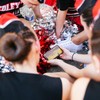This article originally appeared on VICE France.Back in 2017, photographer Amélie Canon was looking to explore new subjects in her photography, when she stumbled on the opportunity to follow a team of majorettes (baton twirling dancers usually seen at parades and carnivals) from her native town of Vierzon, central France, and take their portraits. The squad in question was the Medley’dies: winners of multiple titles at the French national majorette championships and at the European level, too.
Advertisement
Captivated by their energy, costumes and shiny props, Canon dreamt of one day returning to cover an entire majorette competition. A few years and a pandemic-induced hiatus later, she finally made it to the French national championship, which took place between the 16th and the 18th of April in the town of Argen, 120km outside of Toulouse. Over the course of three days, 12 teams (220 majorettes in total, aged 6 to 25) took part in a series of competitions divided by age group and category, including pom-pom, baton and canne major (a baton variation). They marched, twirled their props and danced, donning shiny lamé outfits and sparkly eyeshadow.
The Medley’dies.
The exact origin of the majorette discipline is unknown, but it likely started as a part of military parades. Majorettes usually march in formations in army-inspired uniforms to the beat drum corps or fanfares. The discipline sometimes gets confused with cheerleading, but it doesn’t include stunts and is more related to rhythmic gymnastics.In the early 1900s, majorettes started to be incorporated into street parades, and in marching bands at sporting events in the United States. From there, the discipline became more established and practised all over the world. It’s particularly big in some Eastern European countries, where it’s considered almost a national sport. On the other end of the scale are countries like Portugal or Italy, which have never been represented in international championships.
Advertisement
Although the activity is open to anyone, it’s still mostly practised by women and girls. But slowly, more and more boys are getting involved.
What Canon loves most about majorette competitions is “the sweet and powerful moments of sisterhood in the sport,” she says. “There’s also this feeling of passing it on, which is touching. The older competitors come back to coach and support the younger ones through their experience. They’re also there to do hair and make up for the girls, all in single file in the gym’s stands.” These tried and tested traditions are followed precisely and methodically time after time. That’s something that Canon finds both fascinating and comforting. “They’re all there for each other,” she says.More photos by Amelie Canon:

